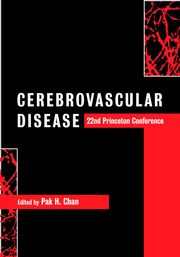Book contents
- Frontmatter
- Contents
- List of contributors
- Preface
- Acknowledgments
- Part I Special lectures
- Part II Oxidative stress
- Part III Apoptosis
- Part IV Hot topics
- Part V Hemorrhage, edema and secondary injury
- Part VI Inflammation
- Part VII Gene transfer and therapy
- Part VIII Neurogenesis and plasticity
- Part IX Magnetic resonance imaging in clinical stroke
- Part X Risk factors, clinical trials and new therapeutic horizons
- 32 Vascular factors in Alzheimer's disease
- 33 Beyond neuroprotection: the protection of axons and oligodendrocytes in cerebral ischemia
- 34 Combining neuroprotection with thrombolysis: how to translate laboratory success to our clinical trials
- 35 Prospects for improved neuroprotection trials in stroke
- 36 Basic research and stroke therapeutics: what have we learned?
- Index
- Plate section
36 - Basic research and stroke therapeutics: what have we learned?
from Part X - Risk factors, clinical trials and new therapeutic horizons
Published online by Cambridge University Press: 02 November 2009
- Frontmatter
- Contents
- List of contributors
- Preface
- Acknowledgments
- Part I Special lectures
- Part II Oxidative stress
- Part III Apoptosis
- Part IV Hot topics
- Part V Hemorrhage, edema and secondary injury
- Part VI Inflammation
- Part VII Gene transfer and therapy
- Part VIII Neurogenesis and plasticity
- Part IX Magnetic resonance imaging in clinical stroke
- Part X Risk factors, clinical trials and new therapeutic horizons
- 32 Vascular factors in Alzheimer's disease
- 33 Beyond neuroprotection: the protection of axons and oligodendrocytes in cerebral ischemia
- 34 Combining neuroprotection with thrombolysis: how to translate laboratory success to our clinical trials
- 35 Prospects for improved neuroprotection trials in stroke
- 36 Basic research and stroke therapeutics: what have we learned?
- Index
- Plate section
Summary
Although there now is a generally accepted method for acute stroke therapy in patients, we have encountered many problems in developing additional ones in the last few years. Only one treatment has been unequivocally proven to be beneficial; thrombolytic therapy with tissue plasminogen activator (tPA) is effective in reducing neurological damage with adequate safety. Two other clinical trials have also produced positive results. These were studies of prourokinase, which is also a thrombolytic, and ancrod, which reduces fibrinogen levels and may have some thrombolytic properties. Neither of these treatments has yet been approved by regulatory agencies for treatment of stroke victims.
At the time of writing, all clinical trials of neuroprotective agents have failed to provide clear evidence of reduction in neurological injury. Table 36.1 provides a list of many of these drugs. There are probably a number of reasons for the difficulties that were encountered. Examination of the successful trials, as contrasted with the failures, may give us some insight into how to better design future studies. The National Institutes of Health (NIH) tPA trial was the only unambiguously successful trial. There was approximately a 50% relative risk improvement in neurological function recovery when the scales were dichotomized to unimpaired vs. impaired, and there was not an increase in adverse outcomes (including death). A critical feature of the NIH tPA trial was that all of the patients were treated within 180 minutes after onset of systems, and half of the subjects were treated within 90 minutes.
- Type
- Chapter
- Information
- Cerebrovascular Disease22nd Princeton Conference, pp. 444 - 451Publisher: Cambridge University PressPrint publication year: 2002



